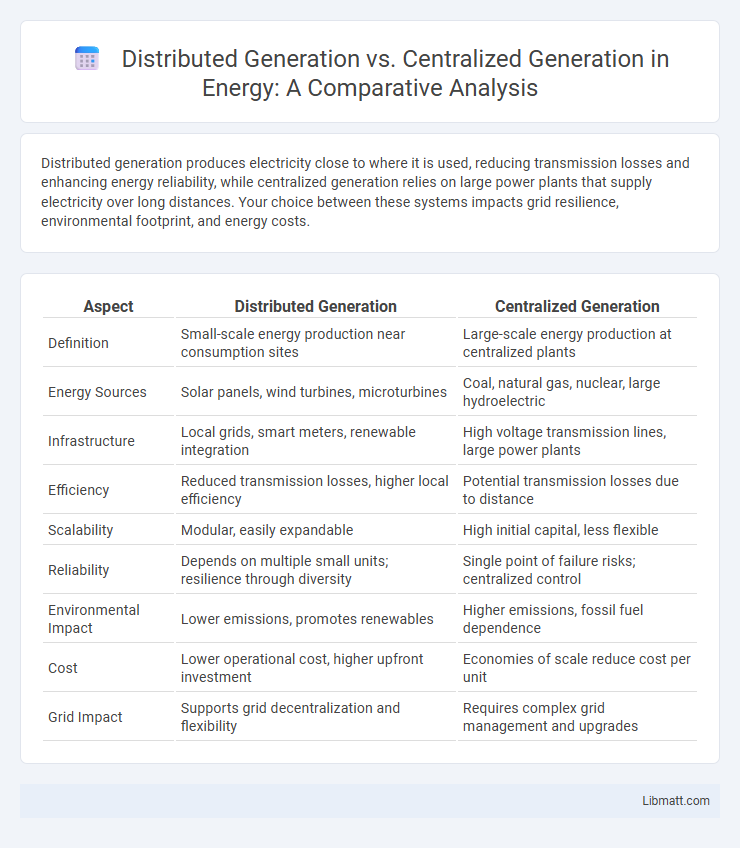Distributed generation produces electricity close to where it is used, reducing transmission losses and enhancing energy reliability, while centralized generation relies on large power plants that supply electricity over long distances. Your choice between these systems impacts grid resilience, environmental footprint, and energy costs.
Table of Comparison
| Aspect | Distributed Generation | Centralized Generation |
|---|---|---|
| Definition | Small-scale energy production near consumption sites | Large-scale energy production at centralized plants |
| Energy Sources | Solar panels, wind turbines, microturbines | Coal, natural gas, nuclear, large hydroelectric |
| Infrastructure | Local grids, smart meters, renewable integration | High voltage transmission lines, large power plants |
| Efficiency | Reduced transmission losses, higher local efficiency | Potential transmission losses due to distance |
| Scalability | Modular, easily expandable | High initial capital, less flexible |
| Reliability | Depends on multiple small units; resilience through diversity | Single point of failure risks; centralized control |
| Environmental Impact | Lower emissions, promotes renewables | Higher emissions, fossil fuel dependence |
| Cost | Lower operational cost, higher upfront investment | Economies of scale reduce cost per unit |
| Grid Impact | Supports grid decentralization and flexibility | Requires complex grid management and upgrades |
Introduction to Power Generation Models
Distributed generation involves producing electricity from multiple, small-scale sources close to the point of consumption, enhancing grid resilience and reducing transmission losses. Centralized generation relies on large power plants, often fueled by coal, natural gas, or nuclear energy, delivering electricity through extensive transmission networks to end-users. The shift toward distributed energy resources, including solar panels and wind turbines, supports renewable integration and demand-side management, contrasting with the traditional centralized approach focused on economies of scale.
Defining Distributed Generation
Distributed generation refers to electricity production at or near the point of use, utilizing small-scale power sources such as solar panels, wind turbines, and fuel cells. Unlike centralized generation, where large power plants supply energy over long distances through transmission grids, distributed generation reduces transmission losses and enhances grid reliability. Your energy system benefits from increased resilience and flexibility by integrating these localized power sources.
Understanding Centralized Generation
Centralized generation refers to the production of electricity at large-scale power plants located far from consumers, typically using fossil fuels, nuclear energy, or hydroelectric power. These facilities transmit electricity over extensive high-voltage transmission networks to distribution systems and end-users, relying on centralized control and infrastructure. The model benefits from economies of scale but faces challenges such as transmission losses and vulnerability to large-scale outages.
Key Differences Between Distributed and Centralized Generation
Distributed generation involves producing electricity near the point of use, utilizing renewable sources like solar panels or small wind turbines, which reduces transmission losses and enhances grid resilience. Centralized generation relies on large-scale power plants, such as coal, natural gas, or nuclear facilities, supplying electricity through extensive transmission networks, often leading to higher delivery costs and vulnerability to outages. Your choice between the two impacts energy efficiency, system reliability, and environmental footprint.
Technological Infrastructure and Components
Distributed generation relies on decentralized energy sources such as solar panels, wind turbines, and small-scale generators interconnected through smart grids and advanced inverters, enabling real-time energy management and increased grid resilience. Centralized generation depends on large power plants with high-capacity turbines, transformers, and extensive transmission lines designed for bulk power production and long-distance distribution. Your energy infrastructure strategy must consider the complexity and scalability of components in both systems to optimize efficiency and reliability.
Grid Integration and Management
Distributed generation enhances grid integration by reducing transmission losses and improving resilience through localized power sources like solar panels and small wind turbines. Centralized generation relies on large-scale plants that require extensive transmission infrastructure and complex grid management to balance supply and demand across vast areas. Your energy system benefits from distributed generation's flexibility, enabling more efficient and adaptive grid management in response to variable renewable energy inputs.
Efficiency and Energy Loss Considerations
Distributed generation systems reduce energy losses by producing power closer to the point of consumption, improving overall efficiency compared to centralized generation, which suffers from transmission losses over long distances. Centralized plants often achieve higher operational efficiencies due to economies of scale and advanced technologies, but their efficiency is offset by losses in high-voltage transmission and distribution networks. Optimizing energy delivery requires balancing the localized efficiency benefits of distributed generation with the high-output efficiency of centralized systems.
Environmental and Economic Impacts
Distributed generation reduces environmental impact by utilizing renewable sources like solar and wind locally, minimizing greenhouse gas emissions and transmission losses. Economically, it lowers energy costs by reducing infrastructure expenses and enhancing grid resilience, which decreases outage-related costs. Centralized generation often relies on fossil fuels, leading to higher emissions and environmental degradation, while incurring significant transmission and distribution losses that increase overall energy prices.
Challenges and Limitations of Both Systems
Distributed generation faces challenges such as grid integration complexity, intermittent renewable sources, and higher initial costs for small-scale units. Centralized generation struggles with long transmission losses, vulnerability to large-scale outages, and significant environmental impacts from fossil fuel dependence. Your choice between these systems should consider reliability, scalability, and sustainability factors in energy planning.
Future Trends and Innovations in Power Generation
Distributed generation is rapidly advancing with innovations such as smart grids, energy storage integration, and renewable technologies like solar photovoltaic and wind turbines, enabling decentralized energy production close to consumption points. Centralized generation continues to evolve with the adoption of high-efficiency combined-cycle gas turbines, carbon capture and storage (CCS), and nuclear small modular reactors (SMRs) to meet large-scale demand with reduced emissions. Future trends indicate a hybrid energy system combining distributed and centralized generation, optimized through artificial intelligence and blockchain for enhanced grid resilience and sustainability.
Distributed generation vs Centralized generation Infographic

 libmatt.com
libmatt.com